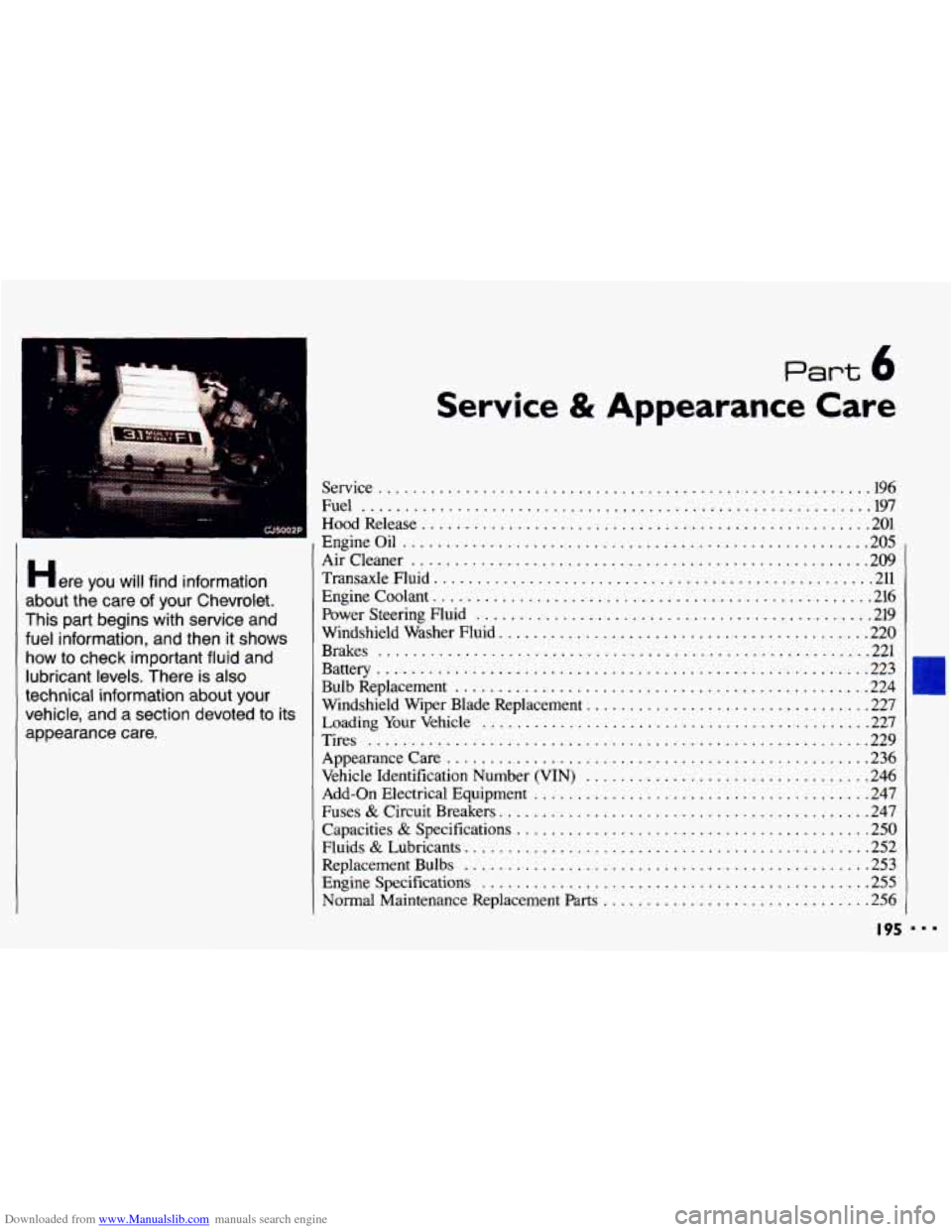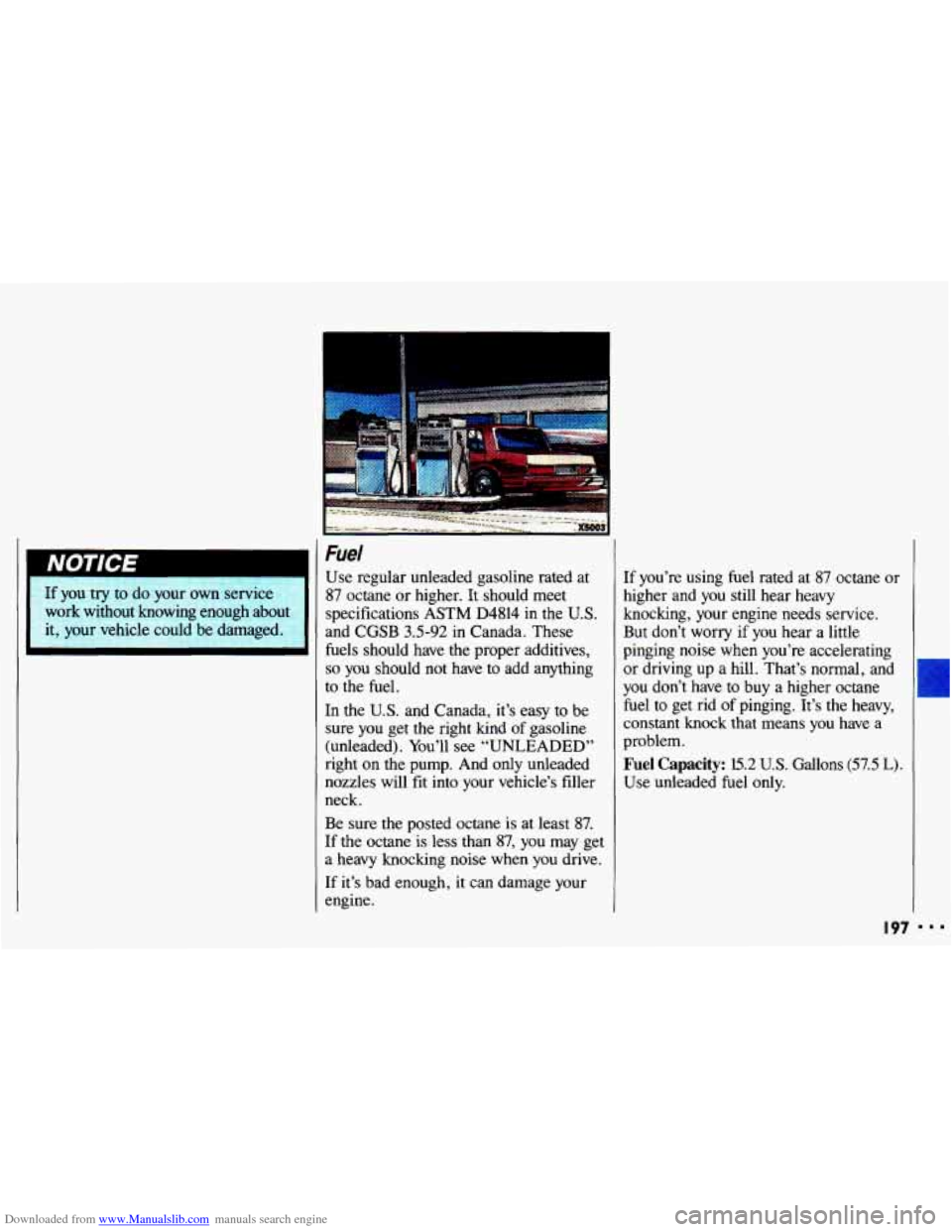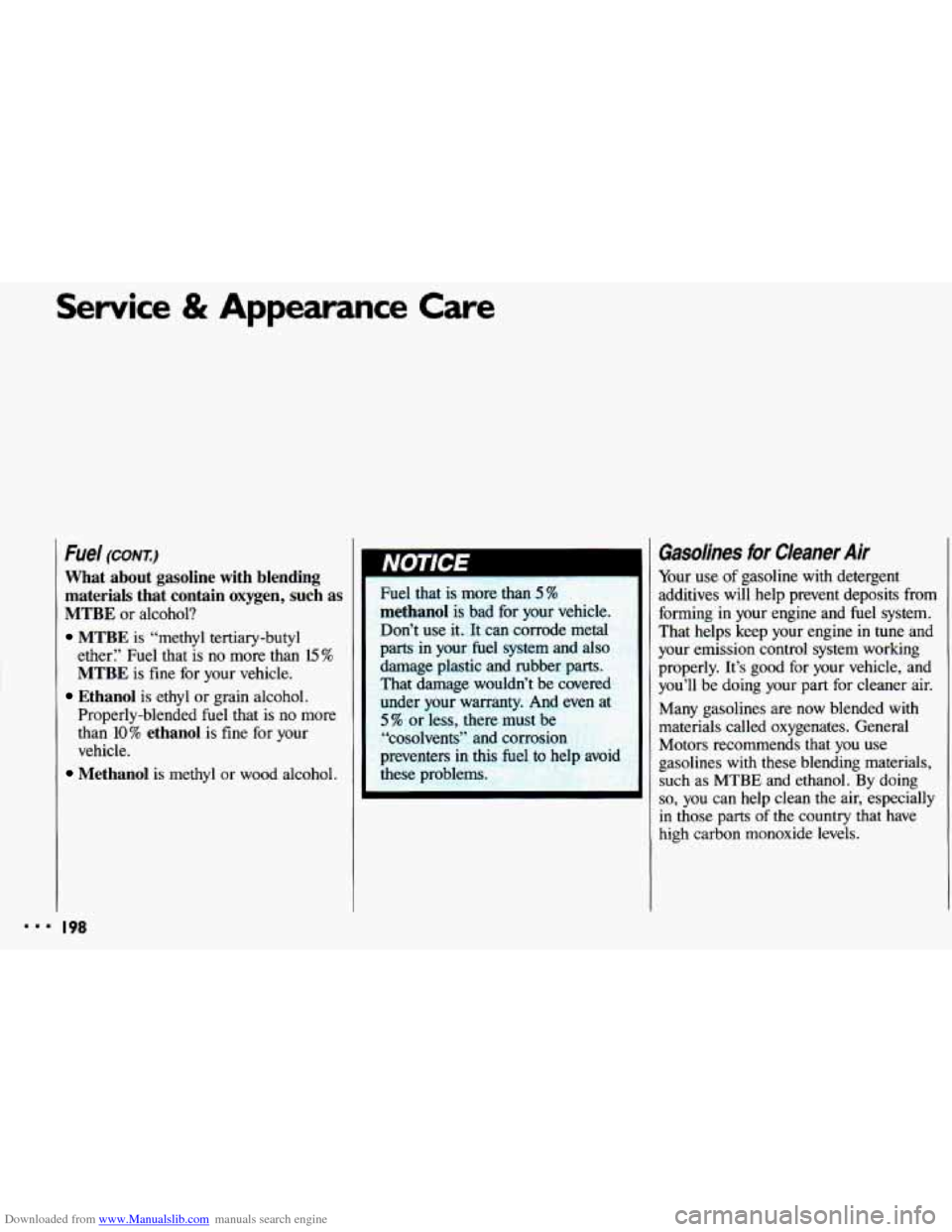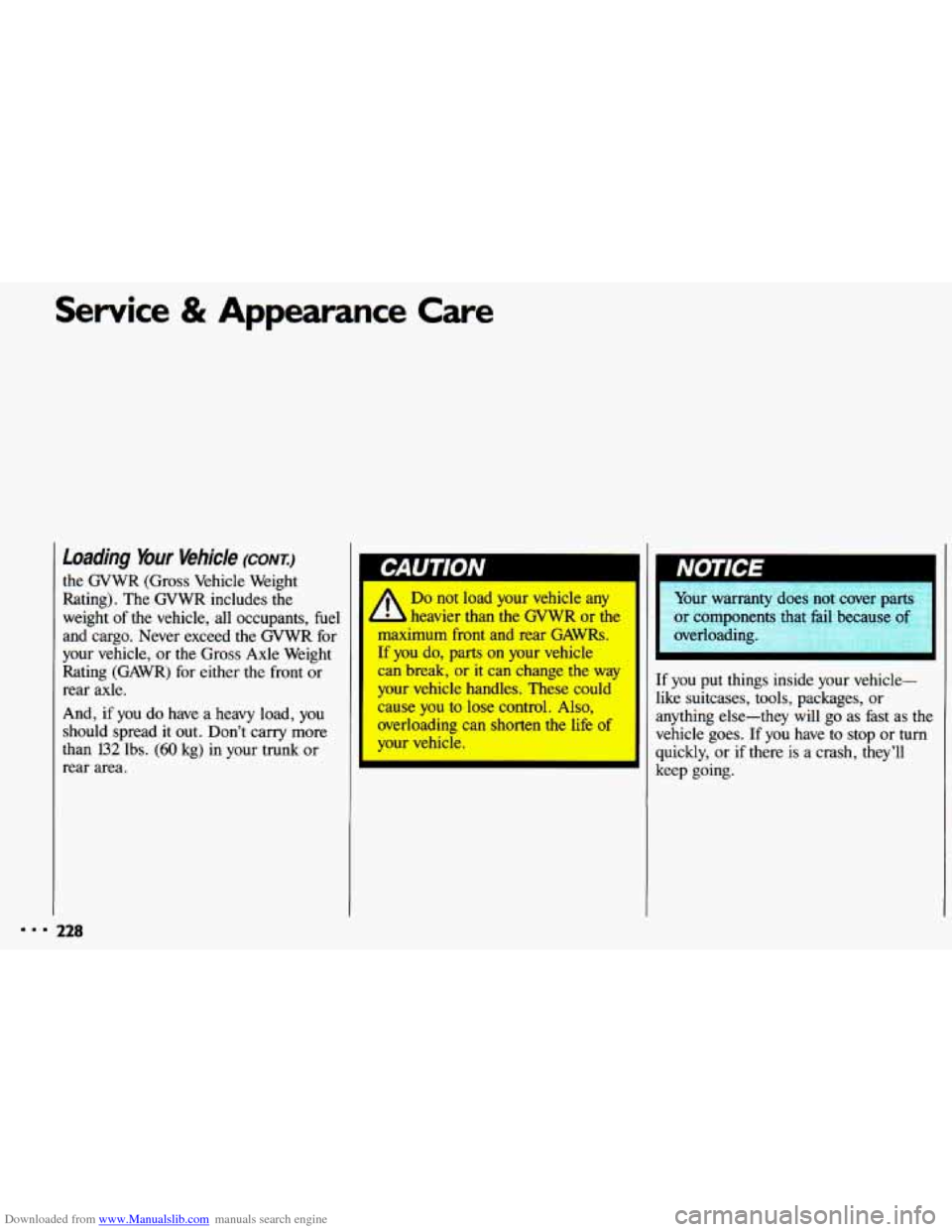Page 197 of 308

Downloaded from www.Manualslib.com manuals search engine i
.....
.................................. ...................
........ ... . &5
..... ..... .... .. --
' . I .. ~
Here you wit1 find information
about the care
of your Chevrolet .
This part begins with service and
fuel information. and then
it shows
how to check important fluid and
lubricant levels
. There is also
technical information about your
vehicle. and
a section devoted to its
appearance care
.
Part 6
Service & Appearance Care
Service ......................................................... 196
Fuel ........................................................... 197
HoodRelease
.................................................... 201
EngineOil
...................................................... 205
Aircleaner
..................................................... 209
Transaxle Fluid
................................................... 211
Engine Coolant
................................................... 216
Power Steering Fluid
.............................................. 219
Windshield Washer Fluid
........................................... 220
Brakes
......................................................... 221
Battery
......................................................... 223
BulbReplacement
................................................ 224
Windshield Wiper Blade Replacement
................................. 227
Loading
Your Vehicle ............................................. 227
Vehicle Identification Number (VIN)
................................. 246
Add-on Electrical Equipment
....................................... 247
Fuses
& Circuit Breakers ........................................... 247
Capacities & Specifications ......................................... 250
Fluids & Lubricants ............................................... 252
Replacement Bulbs
............................................... 253
Engine Specifications
............................................. 255
Normal Maintenance Replacement
Parts ............................... 256
Tires .......................................................... 229
Appearancecare
................................................. 236
I95
Page 199 of 308

Downloaded from www.Manualslib.com manuals search engine If you try to do your own servic
work without knowing enough abot it, your vehicle could be damaged.
Fuel
Use regular unleaded gasoline rated at
87 octane or higher. It should meet
specifications ASTM D4814 in the U.S.
and CGSB
3.5-92 in Canada. These
fuels should have the proper additives,
so you should not have to add anything
to the fuel.
In the U.S. and Canada, it’s easy to be
sure you get the right kind
of gasoline
(unleaded). You’ll see “UNLEADED”
right on
the pump. And only unleaded
nozzles will
fit into your vehicle’s filler
neck.
Be sure the posted octane is at least
87.
If the octane is less than 87, you may get
a heavy knocking noise when you drive.
If it’s bad enough, it can damage your
engine.
If you’re using fuel rated at 87 octane or
higher and
you still hear heavy
knocking, your engine needs service.
But don’t worry
if you hear a little
pinging noise when you’re accelerating
or driving up
a hill. That’s normal, and
you don’t have to buy a higher octane
fuel to get rid of pinging. It’s the heavy,
constant knock that means
you have a
problem.
Fuel Capacity: 15.2 U.S. Gallons (57.5 L).
Use unleaded fuel only.
I97
Page 200 of 308

Downloaded from www.Manualslib.com manuals search engine Service & Appearance Care
Fuel (CONTI
What about gasoline with blending
materials that contain oxygen, such
as
MTBE or alcohol?
MTBE is “methyl tertiary-butyl
ether?
Fuel that is no more than 15 %
MTBE is fine for your vehicle.
Ethanol is ethyl or grain alcohol.
Properly-blended fuel that is
no more
than
10% ethanol is fine for your
vehicle.
Methanol is methyl or wood alcohol.
I98
Fuel that is more than 5 %
methanol is bad for your vehicle.
Don’t use it.
It can corrode metal
parts in your fuel system and also
damage plastic and rubber
parts.
That damage wouldn’t be covered
under
your warranty. And even at
5 % or less, there must be
“cosolvents” and corrosion
preventers in th he1 to :lp avoid
these problems.
- -
Gasolines for Cleaner Air
Your use of gasoline with detergent
additives will help prevent deposits from
forming
in your engine and fuel system.
That helps keep your engine
in tune and
your emission control system working
properly. It’s good for your vehicle, and
you’ll be doing your part for cleaner air.
Many gasolines are now blended
with
materials called oxygenates. General
Motors recommends that you use
gasolines with these blending materials,
such as MTBE and ethanol. By doing
so, you can help clean the air, especially
in those parts of the country that have
high carbon monoxide levels.
Page 201 of 308

Downloaded from www.Manualslib.com manuals search engine In addition, some gasoline suppliers are
now producing reformulated gasolines.
These gasolines are specially designed
to reduce vehicle emissions. General
Motors recommends that you use
reformulated gasoline. By doing
so, you
can help clean the air, especially in
those parts of the country that have high
ozone levels.
You should ask your service station
operators if their gasolines contain
detergents and oxygenates, and if they
have been reformulated to reduce
vehicle emissions.
X
Fuels in Foreign Countries
If you plan on driving in another
country outside the
U.S. or Canada,
unleaded fuel may be hard to find.
Do not use leaded gasoline. If you use
even one tankful, your emission controls
won’t work well or at all. With
continuous use, spark plugs can get
fouled, the exhaust system can corrode,
and your engine oil can deteriorate
quickly. Your vehicle’s oxygen sensor
will be damaged. All of that means
costly repairs that wouldn’t be covered
by your warranty.
To check on fuel availability, ask an auto
club, or contact a major
oil company
that does business in the country where
you’ll be driving.
You can also write us at the following
address for advice. Just tell us where
you’re going and give your Vehicle Identification Number (VIN).
General Motors of Canada Ltd.
International Export
- Sales
P.O. Box 828
Oshawa, Ontario LEX 7Ni, Canada
I99
Page 202 of 308
Downloaded from www.Manualslib.com manuals search engine Service & Appearance Care
..I
F
Filling Your lank
I 4Knu l”’”
I
Gasoline vapor is highly
- flammable. It bums violently,
and that can cause very bad
injuries. Don’t smoke if you’re
ar gasoline or refueling your
hicle. Keep sparks, flames, and
loking materials away from
,,soline.
The cap
is behind a hinged door on the
right side of your vehicle.
To take off the cap, turn it slowly to the
left (counterclockwise).
200
rhile refueling, hang the cap inside the
le1 door.
If you get gasoline on you and
then something ignites it, you
could be badly burned. Gasoline
can spray out on you if you open
the fuel filler cap too quickly. This
spray can happen if your
tank is
nearly full, and is more likely in
hot weather. Open the fuel filler
cap slowly and wait for any “hiss”
noise
to stop. Then unscrew the
cap all the way.
{hen you put the cap back on,
turn it to
le right until you hear a clicking noise.
Page 207 of 308
Downloaded from www.Manualslib.com manuals search engine Engine Oil
It’s a good idea to check your engine oil
level every time
you get fuel. In order to
get an accurate reading, the
oil must be
warm and the vehicle must be on level
ground.
Turn off the engine and give the oil a
few minutes to drain back into the oil
pan. If you don’t, the oil dipstick might
not show
the actual level.
To Check Engine Oil:
Pull out the dipstick and clean it with a
paper towel or cloth, then push
it back
in all the way. Remove
it again, keeping
the tip lower.
2.2L L4: Checking Engine Oil
3.1L V6: Checking Engine Oil
205 I..
Page 209 of 308
Downloaded from www.Manualslib.com manuals search engine SAE 5W-30
As shown in the viscosity chart, SAE
5W-30 is best for your vehicle.
However, you can use
SAE 1OW-30 if
it's going to be 0" F (-18" C) or above.
These numbers on
an oil container show
its viscosity, or thickness. Do not use
other viscosity oils such as
SAE 1OW-40
or SAE 20W-50.
Energy Conserving II
Oils with these words on the container
will help you save fuel.
This doughnut-shaped logo (symbol) is
used on most
oil containers to help you
select the correct oil.
You should look for this on the oil
container, and use
only those oils that
display the logo.
GM Goodwrench@ Oil (in Canada, GM
Engine Oil) meets all the requirements
for your vehicle.
Engine Oil Additives
Don't add anything to your oil. Your
Chevrolet dealer is ready to advise if
you think something should be added.
207
.
Page 230 of 308

Downloaded from www.Manualslib.com manuals search engine Service & Appearance Care
Loading Your Vehicle (CONI:)
the GVWR (Gross Vehicle Weight
Rating). The GVWR includes the
weight of the vehicle, all occupants, fuel
and cargo. Never exceed the GVWR for
your vehicle, or the Gross Axle Weight
Rating (GAWR) for either the front or
rear axle.
And,
if you do have a heavy load, you
should spread
it out. Don’t carry more
than
132 lbs. (60 kg) in your trunk or
rear area.
128
Do not load your vehicle any
L b heavier than the GVWR or the
maximum front and rear GAWRs.
If
you do, parts on your vehicle
can break, or
it can change the way
your vehicle handles. These could
cause you to lose control. Also,
overloading can shorten the life of
your vehicle. Your
warranty does not cover part
or components that fail beca
: ol
overloading.
If you put things inside your vehicle-
like suitcases, tools, packages, or
anything else-they
will go as fast as the
vehicle goes. If you have to stop or turn
quickly, or
if there is a crash, they’ll
keep going.